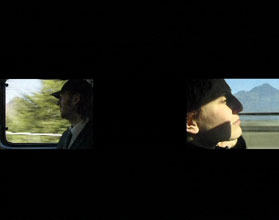Five people struggle to recollect scenes from their favourite movie. They in fact form a quartet, in that one couple shares the task of retelling a film together. The people describe the site where certain scenes occurred, they attempt to recapture moods or atmospheres and ponder the intransigence of certain characters. While initially placing people in front of the camera in order to loosely narrate a film, Margot Zanni later presses her premise further. Providing the characters with the opportunity to relive and test their memories through direct enactment, eventually she pulls our storytellers out of their private space into a recreated 'film-environment' that mimics yet redresses the film cited. Though viewers will likely recognize one or two of the films described - especially Jim Jarmusch's 'Mystery Train' and Wim Wenders' 'Paris, Texas', from which certain shots are carefully reconstructed Ð the identification of the films
is not the main point here. Clearly Zanni's work is not dealing with the filmic experience per se but with identification, memory and narrative. The characters' restagings in the mountainous Swiss countryside of scenes derived from films that are curiously situated in distinctly American landscapes (the deserts of the southwest in Paris, Texas and the urban environs of Memphis in Mystery train) points to this emphasis on the personal identification with the material. It also suggests a similar interest in communication over distance (a theme that we can find in different forms in all the stories cited by the narrators), envisioning memory as a structuring device that connects different times and spaces. Yet these stagings are remade on a landscape that literally unites these memories to the point that, quite climatically, one character seems to cross over into the landscape of another. The four stories suggest four different approaches to memory, description and narration. The work is ended by one woman's precise imitation of a male actors' meaningful look at a woman. This eye contact becomes not only the all-important element of the film described but also the locus for the narrator's identification. The couple's attempt to recall another couple, using perhaps the most common descriptive manner filling each other in on facts and situations, is offset in symmetry with
a lone man and woman who separately dwell on experiences
of isolation and solitude, the one being driven by considerations
of character and the other by an absorption in mood and locale.
The formal structure of the work reiterates the theme of isolation and communication over distance. Zanni is always reconfiguring space in her work, reflecting on these isolations, associations and distances. A black gulf may divide the lone male and female figures or it may punctuate and shift their discourse to create counterpoint. Though framed in their own space by the different projection screens, they relate to each other in a temporal simultaneity, crossing paths through the creation of an effective montage that helps balancing and integrating these narrations. Towards the end as the three screens stitch together to create a panorama, the work briefly fabulizes itself as a cinemascope image. Re-imagining the empty landscape frame from Paris, Texas as an open ended terrain of identification, the viewer is pulled into the cinematic space as the male figure strides off into the distance.
– Alice Smits
|
With Natalia Gerosa, Yumiko Yamaoka, Joe Stefano, Iris Baumann, Nina Steinemann, Rene Sager. Camera Kaleo Labelle, sound and light Michel Gilgen, music Joe Stefano, Raffaela Felder
Margot Zanni ° 1971 Ettiswil, Switzerland
Lives and works in Zürich, Switzerland
|
|
